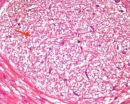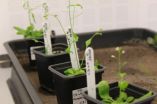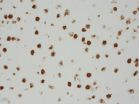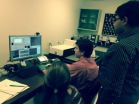(Press-News.org) Exploding stars, random impacts involving comets and meteorites, and even near misses between two bodies can create regions of great heat and high pressure.
Researchers from Imperial College London have now developed a method for analysing the pressure experienced by tiny samples of organic material that may have been ejected from dying stars before making a long journey through the cosmos. The researchers have investigated a type of aromatic hydrocarbon called dimethylnaphthalene, which should enable them to identify violent events in the history of the universe.
Samples of dimethylnaphthalene are found in meteorites. Previously, scientists have only had the ability to investigate how they have been affected by heat. The Imperial researchers say their method for detecting periods when dimethylnaphthalenes have experienced high pressure will now allow for a much more comprehensive analysis of organic materials.
Dr Wren Montgomery, co-author from the Department of Earth Science and Engineering at Imperial College London, says: "The ability to detect high pressure environments in space has tremendous implications for our ability to learn more about the formation of our solar system and the universe. Dimethylnaphthalenes are like microscopic barometers and thermometers recording changes in pressure and heat as they travel through space. Understanding these changes lets us probe their history, and with that, the history of the galaxy."
In the study, the researchers placed a sample of dimethylnaphthalene, the width of a human hair, between the vice like grip of two anvils made out of gem-quality diamonds in a laboratory at the Swiss Light Source. They then applied pressure, recreating the type of high pressure environment that dimethylnaphthalene could experience in space. Using an infrared light from the synchrotron at the facility, Dr Montgomery and her colleagues were able to clearly determine the alterations that happen to the molecular structure of dimethylnaphthalene when experiencing high pressure.
By applying different pressures, the team were able to vary the change in the molecular structure of dimethylnaphthalene, giving an insight into how different types of pressures in space would alter the molecular structure of the organic material.
The researchers also recreated the experiments at the Paul Scherrer Institut in Switzerland and SOLEIL Synchrotron in France to verify their research.
The next step will see the team carrying out more lab work where they will be subjecting other types of aromatic hydrocarbons to a range of pressures experienced in space. Dimethylnaphthalene may not always be present in rock samples, so the researchers say it is important to build up a comprehensive catalogue of all aromatic hydrocarbons to understand more about high pressure zones.
This catalogue would be used by scientists in the field to detect molecular markers in their samples that indicate a particular pressure range. Combined with data about the mineralogy and chemistry of the space rock that the aromatic hydrocarbons are encased in, scientists could then deduce the types of violent events that the sample may have been exposed to many millions or billions of years ago on its way to Earth.
The team also believe that their new technique could be applied on Mars, potentially using the existing technology on-board roving laboratories such as the one on the Mars Science Laboratory Mission to glean information about sources of organic matter on the red planet. Recognising the pressures recorded in the aromatic hydrocarbons can help to reveal whether it came from processes generated from ancient living organisms.
Professor Mark Sephton, co-author from the Department of Earth Science and Engineering at Imperial, says: "We now have another instrument to add to our celestial toolbox, which will help us to learn more about high pressure environments in space. Massive heat and pressure waves arcing out through space from cataclysmic events leave an indelible record in these cosmic barometers. It is really exciting to know that we now have a technique at our disposal that will help to reveal pivotal moments in the universe's history."
INFORMATION:
The research is published tomorrow in The Astrophysical Journal.
Contact:
Colin Smith
Senior Research Media Officer - Faculty of Engineering
Tel: +44 (0)20 7594 6712
Duty press officer mobile: +44 (0)7803 886248
Email: cd.smith@imperial.ac.uk
Notes to editors
1. "An organic cosmo-barometer: distinct pressure and temperature effects for methyl substituted polycyclic aromatic hydrocarbons", The Astrophysical Journal, published in hard copy on Tuesday 1 April 2014.
Wren Montgomery [1], Jonathan S. Watson [1] , Mark Sephton [1]
Imperial College London, South Kensington Campus
A copy of the study is available on request. Please contact Colin Smith (see contact details above).
2. About Imperial College London
Consistently rated amongst the world's best universities, Imperial College London is a science-based institution with a reputation for excellence in teaching and research that attracts 14,000 students and 6,000 staff of the highest international quality. Innovative research at the College explores the interface between science, medicine, engineering and business, delivering practical solutions that improve quality of life and the environment - underpinned by a dynamic enterprise culture.
Since its foundation in 1907, Imperial's contributions to society have included the discovery of penicillin, the development of holography and the foundations of fibre optics. This commitment to the application of research for the benefit of all continues today, with current focuses including interdisciplinary collaborations to improve global health, tackle climate change, develop sustainable sources of energy and address security challenges.
'Cosmic barometer' could reveal violent events in universe's past
2014-03-31
ELSE PRESS RELEASES FROM THIS DATE:
Hearing loss affects old people's personality
2014-03-31
The researchers studied 400 individuals 80-98 years old over a six-year period. Every two years, the subjects were assessed in terms of physical and mental measures as well as personality aspects such as extraversion, which reflects the inclination to be outgoing, and emotional stability. The results show that even if the emotional stability remained constant over the period, the participants became less outgoing.
Interestingly, the researchers were not able to connect the observed changes to physical and cognitive impairments or to age-related difficulties finding social ...
Mild hypothermia for treatment of diffuse axonal injury: A quantitative DTI analysis
2014-03-31
Mild hypothermia has been shown to exert apparent neuroprotective effects in animal models of diffuse axonal injury. However, the clinical efficacy of mild hypothermia is controversial. Thus, a noninvasive, accurate, and objective technique is urgently required to verify the effect of mild hypothermia in diffuse axonal injury and its prognosis. Fractional anisotropy values in diffusion tensor imaging (DTI) can quantitatively reflect the consistency of nerve fibers after brain damage, where higher values generally indicate less damage to nerve fibers. Therefore, Guojie Jing ...
Emotional children's testimonies are judged as more credible
2014-03-31
In an experimental legal psychology study, two young actors (one girl and one boy) portrayed victims in a mock-police investigation. They were questioned by the police about how they had been harassed by older schoolmates. The police interviews were videotaped in two versions: In one version the children appeared in a neutral manner but in the other version, the children showed clear signs of distress, as they sobbed and hesitated before answering the police officers' questions.
The films were later shown and assessed by law students that were familiar with the Supreme ...
Nano-paper filter removes viruses
2014-03-31
Nanotechnology and Functional Materials, Uppsala University have developed a paper filter, which can remove virus particles with the efficiency matching that of the best industrial virus filters. The paper filter consists of 100 percent high purity cellulose nanofibers, directly derived from nature.
The research was carried out in collaboration with virologists from the Swedish University of Agricultural Sciences/Swedish National Veterinary Institute and is published in the Advanced Healthcare Materials journal.
Virus particles are very peculiar objects- tiny (about ...
CAMH researcher discovers 2 new genes linked to intellectual disability
2014-03-31
(Toronto) March 31, 2014 – Researchers at the Centre for Addiction and Mental Health have discovered two new genes linked to intellectual disability, according to two research studies published concurrently this month in the journals Human Genetics and Human Molecular Genetics.
"Both studies give clues to the different pathways involved in normal neurodevelopment," says CAMH Senior Scientist Dr. John Vincent, who heads the MiND (Molecular Neuropsychiatry and Development) Laboratory in the Campbell Family Mental Health Research Institute at CAMH. "We are building up a ...
NTS's role in the protection of pre-moxibustion on gastric mucosal lesions
2014-03-31
Moxibustion may have protective effects on the stomach mucous membrane against stress gastric ulcer. The potential mechanism of moxibustion may be mediated by transforming growth factor-α, gastric mucosa cell proliferation, inhibition of apoptosis, and the expression of heat shock protein-70. Previous studies have shown that somatic sensation by acupuncture and visceral nociceptive stimulation can converge in the nucleus tractus solitarii (NTS) where neurons integrate signals impacting on the function of organs. To explore the role of the NTS in the protective mechanism ...
New study finds biochar stimulates more plant growth but less plant defense
2014-03-31
In the first study of its kind, research undertaken at the University of Southampton has cast significant doubt over the use of biochar to alleviate climate change.
Biochar is produced when wood is combusted at high temperatures to make bio-oil and has been proposed as a method of geoengineering. When buried in the soil, this carbon rich substance could potentially lock-up carbon and reduced greenhouse gas emissions. The global potential of biochar is considered to be large, with up to 12 percent of emissions reduced by biochar soil application.
Many previous reports ...
Major breakthrough in stem cell manufacturing technology
2014-03-31
Scientists at The University of Nottingham have developed a new substance which could simplify the manufacture of cell therapy in the pioneering world of regenerative medicine.
Cell therapy is an exciting and rapidly developing area of medicine in which stem cells have the potential to repair human tissue and maintain organ function in chronic disease and age-related illnesses. But a major problem with translating current successful research into actual products and treatments is how to mass-produce such a complex living material.
There are two distinct phases in the ...
Wen Dan Tang improves insomnia-related anxiety
2014-03-31
Ghrelin, a brain-gut peptide that induces anxiety and other abnormal emotions, contributes to the effects of insomnia on emotional behavior. In contrast, the traditional Chinese Medicine remedy Wen Dan Tang reduces insomnia-related anxiety, which may perhaps correspond to changes in the brain-gut axis. This suggests a possible relationship between Wen Dan Tang's pharmacological mechanism and the brain-gut axis. Based on this hypothesis, a research team from Beijing University of Chinese Medicine in China generated a sleep deprivation rat model, and orally administered Wen ...
A breakthrough in creating invisibility cloaks, stealth technology
2014-03-31
Controlling and bending light around an object so it appears invisible to the naked eye is the theory behind fictional invisibility cloaks.
It may seem easy in Hollywood movies, but is hard to create in real life because no material in nature has the properties necessary to bend light in such a way. Scientists have managed to create artificial nanostructures that can do the job, called metamaterials. But the challenge has been making enough of the material to turn science fiction into a practical reality.
The work of Debashis Chanda at the University of Central Florida, ...






